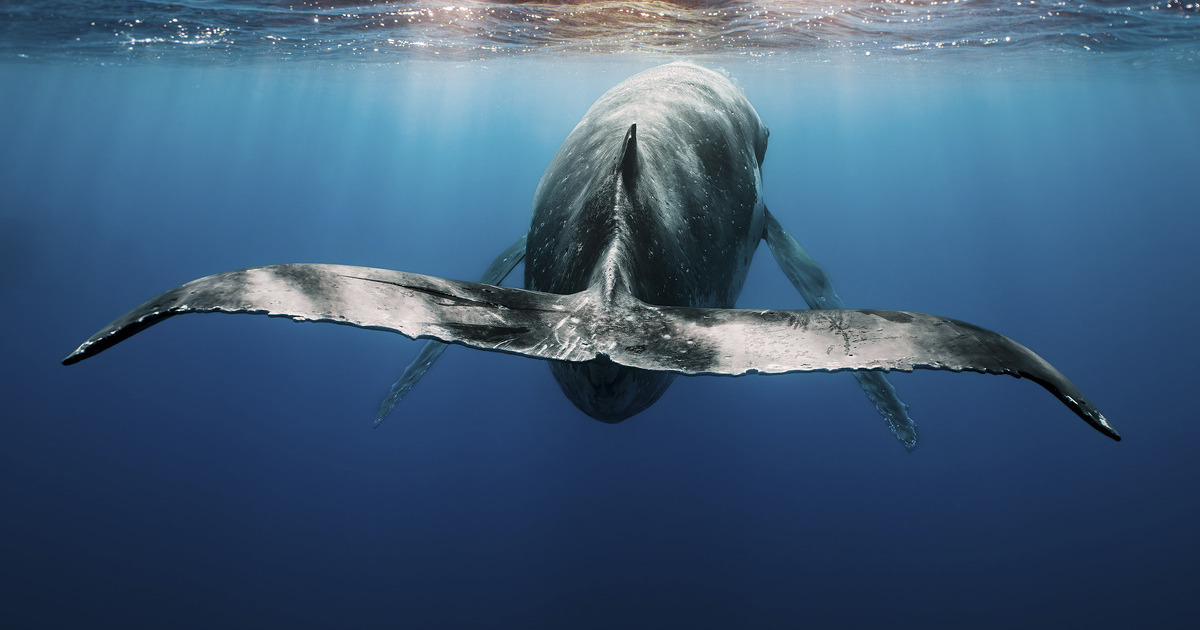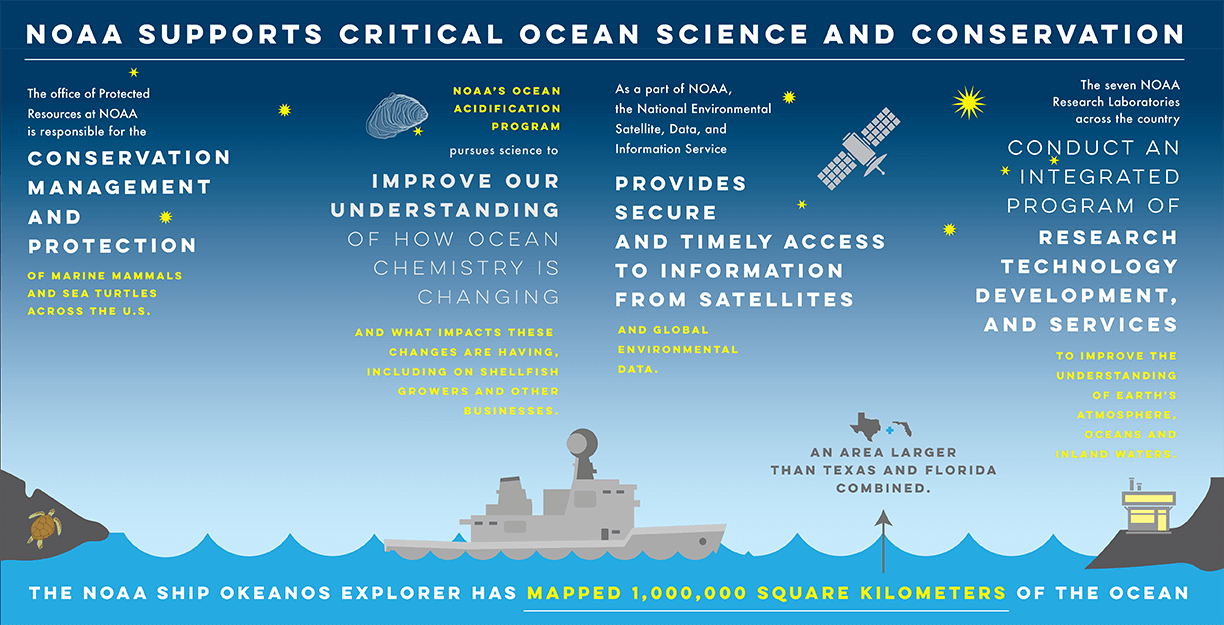
The More You NOAA
Local Benefits of our Nation’s Premiere Ocean and Coastal Agency
Our ocean and coastlines are a vital part of America’s culture and economy, touching the lives of millions of people everyday. Taking care of our ocean, coastal and marine resources and weather and climate modeling systems at the federal level is the National Oceanic and Atmospheric Administration (NOAA). NOAA’s work and services provide immense benefits to local communities and our country as a whole. Put simply, we could not function without it. But what does NOAA actually do and how does it impact you?
Why We Need NOAA
For NOAA to continue to provide support to people and our planet, or even expand on it, it is crucial NOAA has the funds and the capacity to work for us. That means we need our federal policymakers to continue to provide strong funding for NOAA during the annual appropriations process.
- Confronting Climate Change
- Creating & Protecting Healthy Coastlines
- Producing Vital Science & Data
- Spurring Our Blue Economy
- Sustaining Our Fisheries
Confronting Climate Change
The ocean has absorbed more than 90% of the heat generated by humans burning fossil fuels and roughly one-third of our carbon dioxide emissions. This has put extreme stress on our ocean resulting in ocean acidification, sea-level rise, and stronger and more frequent hurricanes. To protect our ocean from climate change, it is vital we understand what is happening in our waters and find solutions—such as restoring coastal habitats—that can build resilience for communities and ecosystems. NOAA is a critical part of this.
NOAA increases our understanding of the climate, facilitates the transition to clean ocean energy and provides tools and resources to help leaders make informed decisions about climate risks and resilience.
- NOAA tracks nine essential indicators of climate change on a global scale, providing detailed data on the changes over time. They are the preeminent source of information on rising global temperatures and increasing extreme weather events.
- NOAA helps to deploy offshore wind by providing critical data and analysis on ocean conditions, coordinating with other federal agencies like the Bureau of Ocean Energy Management (BOEM) to meet all the requirements for marine protection, conducting the environmental studies during permitting and continuously monitoring these sites once deployed.
- Our ocean is absorbing more carbon dioxide than it can handle, leading to lower pH and greater acidity. NOAA’s Ocean Acidification Program is studying this fundamental change in the chemistry of our waters, to better understand how it might impact marine life, people and communities.
Creating and Protecting Healthy Coastlines
The United States has 95,500 miles of shoreline around its borders attracting both residents and visitors. Nearly 40% of the United States population lives in coastal counties. Additionally, Americans make more than 400 million visits to the beach every year. For our coastal habitats to thrive and for our beaches to be appealing to visitors, it is vital that our coasts are healthy and free from debris.
NOAA, as the caretaker of our ocean, is the federal leader in keeping our beaches and coastlines clean and working to restore and protect our critical coastal and in-shore habitats.
- NOAA’s Sea Grant Program, which supports local residents, universities and nonprofits in protecting and restoring habitat, fueled the restoration of more than 1.12 million acres of coastal habitat in 2021.
- In 2022, local and regional programs removed 3,000 metric tons of debris from our oceans, beaches and waterways, thanks to funding from the NOAA Marine Debris Program.
- NOAA’s National Estuarine Research Reserve System cares for more than 1.4 million acres of estuary in the U.S., providing cutting-edge research, training for local and state officials, and educational opportunities for thousands of school children each year.
- NOAA is responsible for the protection, conservation, and recovery of more than 160 endangered and threatened marine and anadromous species under the Endangered Species Act.
- NOAA integrates its work with indigenous communities to gather traditional ecological knowledge, restore habitats, protect marine species, and preserve our coastal cultures.
Producing Vital Science and Data
The ocean is an important driver of weather and climate and is integral to our food supply and economy, yet it is one of the least understood systems on earth. Unbiased science is critical to better understand and effectively manage our ocean resources, guide national policy decisions, promote economic growth and conserve the ocean as an irreplaceable treasure for future generations.

Spurring Our Blue Economy
Coastal communities and ocean-dependent businesses are a major economic engine for the United States. The blue economy contributes $397 billion to the nation’s gross domestic product through activities like tourism and recreation, shipping and transportation, commercial and recreational fishing, power generation, research, and related goods and services. In 2019, the American blue economy grew faster than the nation’s economy in its entirety, supporting 2.4 million jobs.
NOAA is critical to the prosperity and security of our blue economy, providing essential understanding, environmental health and sustainable use guidance of our ocean resources, coasts and Great Lakes.
- NOAA publishes the annual Economics: National Ocean Watch with data detailing the impact of ocean industries to better inform coastal businesses and decisionmakers.
- 95% of U.S. international trade moves through our nation’s ports and harbors. NOAA’s Physical Oceanographic Real Time System (PORTS) provides real-time oceanographic data and navigation information to promote safe and efficient navigation in and out of U.S. ports.
- NOAA’s Office of Coast Survey creates and maintains more than 1,000 nautical charts covering 3.4 million square miles of water, used daily by mariners, the Department of Defense, commercial shipping operations, fishermen, local officials, and many more.
- NOAA, through the National Working Waterfront Network, helps coastal communities to make smart decisions that ensure our waterfronts are accessible for diverse uses today and in the future.
Sustaining Our Fisheries
Fishing puts seafood on tables nationwide, provides people from across the country with jobs and recreational opportunities, and supports cultural practices of Indigenous peoples. In fact, United States marine fisheries are the largest in the world—covering 4.4 million square miles of ocean. Commercial and recreational fishing combined support 1.7 million jobs and produce $253 billion in sales. To keep these industries thriving, it is essential our fisheries are sustainable.
NOAA is vital to ensuring that sustainable fisheries and their habitats are productive, climate-ready and resilient long-term.
- NOAA studies and assesses nearly 500 fish stocks to enable their conservation and sustainable management. The agency also works with the regional fishery management councils to set guidance for the fishing industry.
- NOAA oversees more than 3.36 million square miles of ocean, working to sustainably manage fish populations and protect threatened marine species.
- Since 1992, NOAA has contributed more than $750 million to implement 3,300 projects, which have restored more than 152,000 acres of habitat and opened more than 6,700 stream miles for fish migration.
- Since 2000, NOAA has worked with scientists, managers, and fishermen to rebuild 49 fish populations back to healthy levels after being overfished.
- NOAA works to bring climate and ecosystem information to bear, to support decision-making to reduce the impacts of climate change, build resilience of fish stocks, and sustain our marine resources.